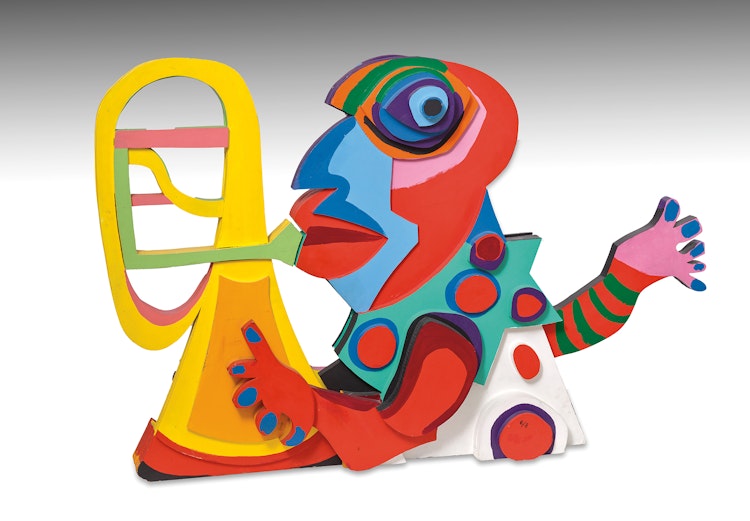Amsterdam Clown from the Circus Series by Karel Appel

Karel Appel
Amsterdam Clown from the Circus Series
acrylic on wood
signed and dated 1977 lower left and numbered 6/8 on the reverse. Published by ABCD Gallery, Paris
48.5 x 73.5 x 8.5 in ( 123.2 x 186.7 x 21.6 cm ) ( overall )
Auction Estimate: $10,000.00 - $15,000.00
Price Realized $7,200.00
Sale date: May 21st 2024
Private Collection, Toronto
Harriet de Visser and Roland Hagenberg, “Karel Appel: The Complete Sculpture 1936–1990”, New York, 1990, no. 78–009
Donald Kuspit, “Karel Appel Sculpture: A Catalogue Raisonné”, New York, 1994, pages 60–65
Throughout his career, Appel drew inspiration from the circus and its colourful performers. In describing Appel’s love of the circus and clowns, Donald Kuspit writes: “Appel once said he would have been a clown if he hadn’t become an artist, but of course, to be an artist is to be kind of a clown.” In this work from the 1970s he has depicted a circus clown playing a musical instrument, the performer who wears funny clothes and makeup and who must attempt to make people-especially children-laugh. In the construction of “Amsterdam Clown”, Appel used his customary bold, bright colours and primitive childlike shapes as found in his other works.
Constructed in two sections-the main body and the horn-Appel has translated his achievements in painting into a three–dimensional form. The circus would remain an enduring subject matter for the artist, culminating in the “Circus Suite” of wooden performers, also produced as a suite of colour lithographs.
Share this item with your friends
Karel Appel
(1921 - 2006)
Born on April 25, 1921, in Amsterdam, Karel Appel studied at the Rijksakademie van Beeldende Kunsten and, in 1946, held his first solo show at Het Beerenhuis, Groningen, and participated in Jonge Schilders (Young painters) at the Stedelijk Museum.
Appel drew primarily inspiration from the artists Pablo Picasso, Henri Matisse and Jean Dubuffet. In 1948, he was a member of the Nederlandse Experimentele Groep (Dutch Experimental Group) before establishing the avant-garde movement CoBrA, with Constant Nieuwenhuys, Corneille (Guillaume Cornelis Beverloo), and other painters from Copenhagen, Brussels and Amsterdam. Their unique style challenged abstraction and Surrealism, featuring bold, expressive compositions inspired by children’s doodles and folk art.
Following the group’s disbanding in 1951, Appel travelled extensively and pursued his career between Paris and New York. In 1954, he held his first gallery exhibition in the United States, and the following year, one of his paintings was included in the seminal group exhibition The New Decade at New York’s Museum of Modern Art, displaying his work alongside those by Francis Bacon, Pierre Soulages and Jean Dubuffet. Over time, his practice expanded to include sculpture, screen printing, stained glass and poetry, which continued until his death in Zürich on May 3, 2006.
Today, Appel’s works can be found in various major museums, including the Rijksmuseum in Amsterdam, the Aboa Vetus & Ars Nova in Turku, Finland, and The Phillips Collection in Washington, D.C.

